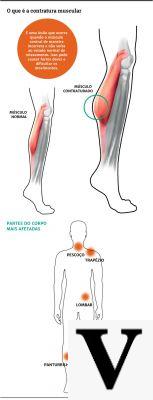
By healthiergang writer , majoring in Medicine and Surgery.
Muscular contracture
Muscle contracture is a high prevalence injury in the world of sportsmen but not only; it is estimated that about 30% of the population has experienced it at least once.
But what is muscle contracture?
By muscle contracture we mean an injury characterized by the involuntary, persistent and painful contraction of one or more skeletal muscles and the rigidity is easily noticeable to the touch: this contraction is nothing more than a physiological defensive act that occurs when the muscle is stressed. beyond its normal limit of endurance; it can affect the muscle totally or partially and, in some cases, also extend to neighboring muscles.
First of all it must be remembered that all physical traumas should be subjected to a specialist medical evaluation, to avoid a possible worsening and that inadequate physical activity can represent an obstacle to the physiological healing process.
Muscle contracture, however, is undoubtedly the least serious of acute muscle injuries, since it does not cause any damage to muscle fibers, as opposed to stretching, distraction, tearing or rupture of muscle fibers; it can affect anyone, even if it inevitably mainly affects sportsmen engaged in disciplines that require explosive effort (bodybuilding, football, running…).
Most Affected Muscles
Statistically most affected muscles are:
- twin muscles
- soleus
- hamstring
- sartorio
- adductors
- trapeze
- lower back, back, and shoulder muscles (which can also occur when performing daily activities, such as mowing the lawn or shoveling snow)
- feet, hands (writer's cramp), arms, face
- buttocks (and in this case it can be easily confused with piriformis syndrome).
The bib numbers, on the other hand, are very rarely involved.
Causes
There are many predisposing causes to this type of injury and, although they have not yet been fully understood, we can certainly classify them in “sporting” and non-sporting causes. Among the former, a primary role is played by the lack of general and specific warm-up, muscle weakness, lack of coordination, inadequate physical preparation, sudden movements, excessive emotional tension, which causes exaggerated activation, execution of new activities for the subject and pathologies articular.
The "non-sporting" causes include a sedentary lifestyle, obesity, postural imbalances, pregnancy. Even smooth muscles can be the site of contracture, this is what occurs, for example, in abdominal colic, in which the intestinal smooth muscle is involved.
Symptoms and effects
The main symptom is certainly pain, usually modest, does not interfere with the continuation of physical activity, followed by lack of elasticity of the affected muscle, stiffness (called hypertonia), swelling and difficulty in movements. Symptoms tend to appear after 8-24 h, and are accompanied by swelling and difficulty in movement.
Depending on the affected muscle there are certain limited and other free movements, for example:
- Trapezius contracture (between the back and shoulder) causes neck pain and limits neck rotation to the same side and lateral inclination to the opposite side.
- The hamstring contracture gives pain in the thigh, reduces the forward movement of the torso (as when putting the socks on the feet).
- The contracture in the calf limits the lifting of the toes (it is done to climb stairs).
- Quadriceps contracture limits knee bending.
The symptomatology is very similar to that of muscle cramp, from which however it can be differentiated since this is mostly linked to energetic / metabolic causes, it presents a faster recovery and a much more intense pain compared to the contracture that obliges the interruption physical activity.
How to behave
To accelerate the recovery, which usually occurs spontaneously, stretching to be associated with a decontracting massage, always operated by expert hands, and the application of kinesio-taping may be useful.
The suspension of training for 3-7 days is an option to be seriously considered, and the use of drugs, such as NSAIDs and muscle relaxants, although useful, should instead be reserved only for the most serious cases and under the supervision of the doctor.
Other small precautions include hot packs (only if the presence of damage to the muscle fibers is excluded with certainty, otherwise risking aggravating the symptoms .... that's why self-medication is always not recommended!), Muds and iontophoresis.
On the front of natural remedies, the use of turmeric and ginger, known anti-inflammatories, Arnica compresses, Devil's claw and Aloe, the latter with a refreshing effect, should be listed.
If the symptomatology persists for more than 10 days, observing the necessary rest, it is advisable to have recourse to the specialist who will make sure that no other pathological processes are in progress; this advice is also valid in case of frequent and repeated contractures, making it necessary to ascertain the presence of a possible myofascial syndrome.
Obviously, the best cure is always prevention!
Therefore, it is enough to follow small tricks such as:
- perform adequate warm-up
- make sure you are in good physical condition before taking the effort
- cover yourself adequately in the winter months
- allow yourself the right recovery
- correct postural and joint imbalances
As seen above, the muscles most affected are those of the lower limbs, so it would be recommended, for preventive purposes, the use of shoes suitable for the physical activity carried out, as well as the use of anti-shock insoles, in order to reduce the risk of only of muscle contracture, but also of the whole series of musculoskeletal disorders due to overload.
Obviously, all this does not guarantee immunity from injuries, but it will allow you to enjoy the physical activity with carefree, confident that you have minimized the possibility that these small annoyances can hit you, forcing you to stop, which we know well be a reason. of displeasure for all small and large sportsmen.


























